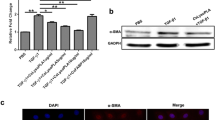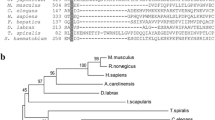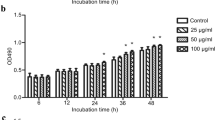Abstract
Lysophospholipase, belonging to the complex family of phospholipases, is supposed to play a vital role in virulence and pathogenesis of parasites and fungi. In the current study, the potential role of Clonorchis sinensis lysophospholipase (CslysoPLA) in hepatic fibrosis induced by C. sinensis was explored for the first time. In the liver of the cat infected with C. sinensis, CslysoPLA was recognized in the lumen between adult worms and surrounding bile duct epithelia together with some inside the cells by means of immunolocalization. Both Cell Counting Kit-8 (CCK-8 assay) and cell cycle analysis of human hepatic stellate cell line LX-2 showed that a higher percentage of cells were at proliferation phase after incubation with lower concentrations of recombinant CslysoPLA (rCslysoPLA). Quantitative real-time polymerase chain reaction (RT-PCR) demonstrated an upregulation in fibrogenic genes of smooth muscle α-actin, collagen III, matrix metalloproteinase 2 and tissue inhibitors of metalloproteinase II in LX-2 treated with rCslysoPLA. Moreover, human biliary epithelial cell line 5100 proliferated significantly in response to rCslysoPLA. Notably, CslysoPLA was localized in the adenomatoid hyperplastic tissue within the intrahepatic bile duct of experimentally infected rats by immunolocalization analysis. In addition, quantitative RT-PCR implied that CslysoPLA was differentially expressed at the developmental stages of C. sinensis (metacercariae, adult worms and eggs), with the highest level at metacercariae stage. Immunolocalization analysis showed that CslysoPLA was distributed in the intestine, vitelline gland, tegument and eggs in the adult worms and in the tegument and vitelline gland in the metacercariae, respectively. Collectively, it suggests that CslysoPLA might be involved in the initiation and promotion of C. sinensis-related human hepatic fibrosis and advance future studies on its promotion to C. sinensis-induced cholangiocarcinogenesis.






Similar content being viewed by others
References
Anthony B, Mathieson W, de Castro-Borges W, Allen J (2010) Schistosoma mansoni: egg-induced downregulation of hepatic stellate cell activation and fibrogenesis. Exp Parasitol 124:409–420
Bartley PB, Ramm GA, Jones MK, Ruddell RG, Li Y, McManus DP (2006) A contributory role for activated hepatic stellate cells in the dynamics of Schistosoma japonicum egg-induced fibrosis. Int J Parasitol 36:993–1001
Bouvard V, Baan R, Straif K, Grosse Y, Secretan B, EI Ghissassi F, Benbrahim-Tallaa L, Guha N, Freeman C, Galichet L, Cogliano V (2009) A review of human carcinogens—part B: biological agents. Lancet Oncol 10:321–322
Cai GB, Bae YA, Kim SH, Sohn WM, Lee YS, Jiang MS, Kim TS, Kong Y (2008) Vitellocyte-specific expression of phospholipid hydroperoxide glutathione peroxidases in Clonorchis sinensis. Int J Parasitol 38:1613–1623
Chang D, Ramalho LN, Ramalho FS, Martinelli AL, Zucoloto S (2006) Hepatic stellate cells in human schistosomiasis mansoni: a comparative immunohistochemical study with liver cirrhosis. Acta Trop 97:318–323
de Oliveira D, de Souza TA, Murate LS, Jankevicius JV, Gaziri LC, Jankevicius SI (2004) Protease and phospholipase inhibition protect Veneza zonata (Hemiptera Coreidae) against septicemia caused by parasite trypanosomatid 563DT. J Invertebr Pathol 85:9–17
Dong Q, Patel M, Scott KF, Graham GG, Russell PJ, Sved P (2006) Oncogenic action of phospholipase A2 in prostate cancer. Cancer Lett 240:9–16
Friedman SL (2004) Mechanisms of disease: mechanisms of hepatic fibrosis and therapeutic implications. Nat Clin Pract Gastroenterol Hepatol 1:98–105
Gao GH, Wang YZ, Wu F, Jin XX, Yuan T (1994) Study on experimental pathology of Clonorchis sinensis. Chin J Parasitic Dis Control 7:197–200
Ghannoum MA (2000) Potential role of phospholipases in virulence and fungal pathogenesis. Clin Microbiol Rev 13:122–143
Herbst H, Wege T, Milani S, Pellegrini G, Orzechowski HD, Bechstein WO, Neuhaus P, Gressner AM, Schuppan D (1997) Tissue inhibitor of metalloproteinase-1 and -2 RNA expression in rat and human liver fibrosis. Am J Pathol 150:1647–1659
Hu F, Hu X, Ma C, Zhao J, Xu J, Yu X (2009) Molecular characterization of a novel Clonorchis sinensis secretory phospholipase A(2) and investigation of its potential contribution to hepatic fibrosis. Mol Biochem Parasitol 167:127–134
Hu Y, Huang L, Huang Y, He L, Zhang F, Li W, Liang P, Li R, Sun J, Wang X, Liang C, Li X, Yu X (2012) Molecular cloning, expression, and immunolocalization of protein disulfide isomerase in excretory–secretory products from Clonorchis sinensis. Parasitol Res 111:983–989
Huang L, Hu Y, Huang Y, Fang H, Li R, Hu D, Li W, Li X, Liang C, Yu X (2011) Gene/protein expression level, immunolocalization and binding characteristics of fatty acid binding protein from Clonorchis sinensis (CsFABP). Mol Cell Biochem 363:367–376
Ishii M, Vroman B, LaRusso NF (1990) Fluid-phase endocytosis by intrahepatic bile duct epithelial cells isolated from a normal rat liver. J Histochem Cytochem 38:515–524
Kim YJ, Choi MH, Hong ST, Bae YM (2008) Proliferative effects of excretory/secretory products from Clonorchis sinensis on the human epithelial cell line HEK293 via regulation of the transcription factor E2F1. Parasitol Res 102:411–417
Kim YJ, Choi MH, Hong ST, Bae YM (2009) Resistance of cholangiocarcinoma cells to parthenolide-induced apoptosis by the excretory-secretory products of Clonorchis sinensis. Parasitol Res 104:1011–1016
Liang C, Hu XC, Lv ZY, Wu ZD, Yu XB, Xu J, Zheng HQ (2009) Experimental establishment of life cycle of Clonorchis sinensis. Zhongguo Ji Sheng Chong Xue Yu Ji Sheng Chong Bing Za Zhi 27:148–150
Lun ZR, Gasser RB, Lai DH, Li AX, Zhu XQ, Yu XB, Fang YY (2005) Clonorchiasis: a key foodborne zoonosis in China. Lancet Infect Dis 5:31–41
Lv X, Chen W, Wang X, Li X, Sun J, Deng C, Men J, Tian Y, Zhou C, Lei H, Liang C, Yu X (2011) Molecular characterization and expression of a cysteine protease from Clonorchis sinensis and its application for serodiagnosis of clonorchiasis. Parasitol Res 110:2211–2219
Ma C, Hu X, Hu F, Li Y, Chen X, Zhou Z, Lu F, Xu J, Wu Z, Yu X (2007) Molecular characterization and serodiagnosis analysis of a novel lysophospholipase from Clonorchis sinensis. Parasitol Res 101:419–425
McManus DP, Bryant C (1986) Biochemistry and physiology of Echinococcus. In: Thompson RCA (ed) The biology of Echinococcus and hydatid disease, 1st edn. George Allen and Unwin, London
Milani S, Herbst H, Schuppan D, Grappone C, Pellegrini G, Pinzani M, Casini A, Calabro A, Ciancio G, Stefanini F, Burroughs AK, Surrenti C (1994) Differential expression of matrix-metalloproteinase-1 and -2 genes in normal and fibrotic human liver. Am J Pathol 144:528–537
Moolenaar WH (1995) Lysophosphatidic acid, a multifunctional phospholipid messenger. J Biol Chem 270:12949–12952
Mora R, Valverde B, Díaz C, Lomonte B, Gutiérrez JM (2005) A Lys49 phospholipase A2 homologue from Bothrops asper snake venom induces proliferation, apoptosis and necrosis in a lymphoblastoid cell line. Toxicon 45:651–660
Morris MJ, Craiq SJ, Sutherland TM, Board PG, Casarotto MG (2009) Transport of glutathione transferase-fold structured proteins into living cells. Biochim Biophys Acta 1788:676–685
Mulvenna J, Moertel L, Jones MK, Nawaratna S, Lovas EM, Gobert GN, Colgrave M, Jones A, Loukas A, McManus DP (2010) Exposed proteins of the Schistosoma japonicum tegument. Int J Parasitol 40:543–554
Pak JH, Kim DW, Moon JH, Nam JH, Kim JH, Ju JW, Kim TS, Seo SB (2009) Differential gene expression profiling in human cholangiocarcinoma cells treated with Clonorchis sinensis excretory–secretory products. Parasitol Res 104:1035–1046
Pfaffl MW (2001) A new mathematical model for relative quantification in real-time RT-PCR. Nucleic Acids Res 29:e45
Rim HJ (2005) Clonorchiasis: an update. J Helminthol 79:269–281
Rojkind M, Giambrone MA, Biempica L (1979) Collagen types in normal and cirrhotic liver. Gastroenterology 76:710–719
Saadat I, Higashi H, Obuse C, Umeda M, Murata-Kamiya N, Saito Y, Lu H, Ohnishi N, Azuma T, Suzuki A, Ohno S, Hatakeyama M (2007) Helicobacter pylori CagA targets PAR1/MARK kinase to disrupt epithelial cell polarity. Nature 447:330–333
Sirica AE, Lai GH, Endo K, Zhang Z, Yoon BI (2002) Cyclooxygenase-2 and ERBB-2 in cholangiocarcinoma: potential therapeutic targets. Semin Liver Dis 22:303–313
Smout MJ, Laha T, Mulvenna J, Sripa B, Suttiprapa S, Jones A, Brindley PJ, Loukas A (2009) A granulin-like growth factor secreted by the carcinogenic liver fluke, Opisthorchis viverrini, promotes proliferation of host cells. PLoS Pathog 5:e1000611
Sripa B, Kaewkes S, Sithithaworn P, Mairiang E, Laha T, Smout M, Pairojkul C, Bhudhisawasdi V, Tesana S, Thinkamrop B, Bethony JM, Loukas A, Brindley PJ (2007) Liver fluke induces cholangiocarcinoma. PloS Med 4:e201
Thamavit W, Bhamarapravati N, Sahaphong S, Vajrasthira S, Angsubhakorn S (1978) Effects of dimethylnitrosamine on induction of cholangiocarcinoma in Opisthorchis viverrini-infected Syrian golden hamsters. Cancer Res 38:4634–4639
Wang A, Dennis EA (1999) Mammalian lysophospholipases. Biochim Biophys Acta 1439:1–16
Wang X, Chen W, Huang Y, Sun J, Men J, Liu H, Luo F, Guo L, Lv X, Deng C, Zhou C, Fan Y, Li X, Huang L, Hu Y, Liang C, Hu X, Xu J, Yu X (2011) The draft genome of the carcinogenic human liver fluke Clonorchis sinensis. Genome Biol 12:R107
Wang X, Chen W, Lv X, Tian Y, Men J, Zhang X, Lei H, Zhou C, Lu F, Liang C, Hu X, Xu J, Wu Z, Li X, Yu X (2012) Identification and characterization of paramyosin from cyst wall of metacercariae implicated protective efficacy against Clonorchis sinensis infection. PLoS One 7:e33703
Wright LC, Payne J, Santangelo RT, Simpanya MF, Chen SC, Widmer F, Sorrell TC (2004) Cryptococcal phospholipases: a novel lysophospholipase discovered in the pathogenic fungus Cryptococcus gattii. Biochem J 384:377–384
Xu L, Hui AY, Albanis E, Arthur MJ, O’Byrne SM, Blaner WS, Mukherjee P, Friedman SL, Eng FJ (2005) Human hepatic stellate cell lines, LX-1 and LX-2: new tools for analysis of hepatic fibrosis. Gut 54:142–151
Yoo WG, Kim TI, Li S, Kwon OS, Cho PY, Kim TS, Kim K, Hong SJ (2009) Reference genes for quantitative analysis on Clonorchis sinensis gene expression by real-time PCR. Parasitol Res 104:321–328
Zheng M, Hu K, Liu W, Hu X, Hu F, Huang L, Wang P, Hu Y, Huang Y, Li W, Liang C, Yin X, He Q, Yu X (2011) Proteomic analysis of excretory secretory products from Clonorchis sinensis adult worms: molecular characterization and serological reactivity of a excretory–secretory antigen-fructose-1,6-bisphosphatase. Parasitol Res 109:737–744
Acknowledgments
This work was supported by the National Key Basic Research and Development Project of China (973 project; no. 2010CB530000), National Natural Science Foundation of China (no. 81101270 and no. 81171602), China Postdoctoral Science Foundation (no. 20110490952), Fundamental Research Funds for the Central Universities (no. 3164015) and the National Important Sci-tech Special Projects (no. 2012ZX10004220).
Author information
Authors and Affiliations
Corresponding author
Additional information
Fan Zhang and Pei Liang have contributed equally to this work.
Rights and permissions
About this article
Cite this article
Zhang, F., Liang, P., Chen, W. et al. Stage-specific expression, immunolocalization of Clonorchis sinensis lysophospholipase and its potential role in hepatic fibrosis. Parasitol Res 112, 737–749 (2013). https://doi.org/10.1007/s00436-012-3194-1
Received:
Accepted:
Published:
Issue Date:
DOI: https://doi.org/10.1007/s00436-012-3194-1




